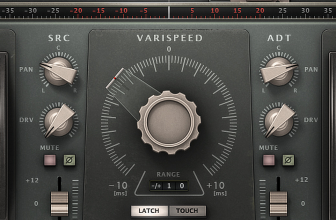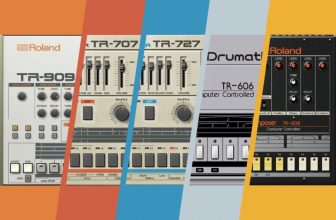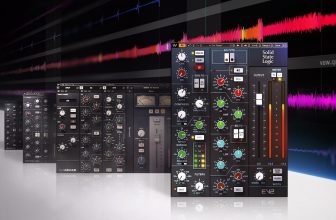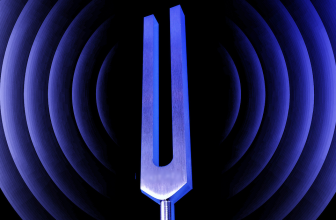
Compressors and transient shapers can both control your transient material and be manipulated for sonic impact. Learn the differences between these two processors so you know when to use each.
By Charles Hoffman, Black Ghost Audio
Compressors and transient shapers can both be used to control the transient response of an audio signal. With that being the case, when does it makes sense to use one type of device instead of the other? To answer this practical question, we need to look at the functional differences between these audio processors. They can both be used to shape transients, but each device has some unique strengths and limitations.
The main difference is that compressors are fundamentally threshold-dependent devices whereas transient shapers are not.
A compressor’s threshold knob dictates the level at which gain reduction occurs. For example, when using a compressor like the SSL G-Master Bus Compressor, compression won’t be applied until you reduce the device’s Threshold level below the level of incoming transient material. You need to tell the compressor that audio content above a certain decibel level is meant to be attenuated using the Attack, Release, and Ratio parameters that you’ve set.
A transient shaper automatically identifies incoming transient material based on fast changes in amplitude. It doesn’t base detection on an absolute peak level—in the way that a compressor does. This means that you can use a transient shaper to sculpt the tonality of quiet transients and loud transients in a similar fashion, without drastically overprocessing loud transients.



Most transient shapers, like Smack Attack, provide an Attack and Sustain control. The Attack control lets you boost or attenuate the transient portion of a sound, while the Sustain control allows you to adjust the level of trailing audio content. A high Sustain value will make the tail end of sounds more present, while a small Sustain value will have the opposite effect.
When to Use a Compressor: Situation #1
Let’s say you’re processing a vocal recording in which the singer keeps shifting around the head of their microphone. As they move closer, the recording gets louder, and as they move further away, the recording gets quieter. Using a compressor to fix this type of issue is a great idea. It’s capable of reducing the level of loud segments of audio to a baseline level. You can adjust the threshold level so that it’s sitting right above the level of quiet dialog, which will reduce the level of all audio material louder than the threshold level. Ideally, you’ll end up with a vocal recording containing semi-consistent peak levels that sounds tighter, punchier, more controlled, and more confident than previously.
When to Use a Compressor – Situation #2
You can also apply compression in a more acute manner to sculpt the transients of a recording. Let’s say you’re processing an overly transient kick drum for a house music song that feels like it’s stabbing you in the eye every time it plays. If the same audio sample was used for each instance of the kick and there’s no velocity automation applied to the kick track, you can easily fix this problem using a compressor. Use a fast attack time around 0.1-10ms and a fast release time around 0.1-0.3s. Then, reduce the value of the threshold knob until the harsh and “stabby” nature of the kick becomes unnoticeable. The result should sound round and punchy.

- Example 1 – Transient
- Example 2 – Punchy
The Limitations of Using a Compressor to Shape Transients
A compressor wouldn’t work as well in the previous situation if you were processing a dynamic kick drum arrangement that included velocity automation, or if you were processing a live kick drum recording that included natural variations in peak level. The problem is that when some of the transients you’re processing are louder than others, a compressor will process loud transients more aggressively than quiet transients.
If you were to successfully reshape loud transients in Situation #2, the quiet transients would still sound “stabby.” Assuming you were to reduce your compressor’s threshold level further to sculpt the quiet transients, the loud transients would become overprocessed and completely lose their punchiness. This is the limitation of using a compressor to sculpt the amplitude envelope of transients.

When to Use a Transient Shaper – Situation #1
It’s quite common to use a transient shaper to shape the amplitude envelope of transients from dynamic recordings. For example, the snare recording of a jazz drummer is going to sound much different than the snare recording of a rock drummer. Depending on the song, a rock drummer is likely to strike their snare drum with the same velocity each time, whereas the jazz drummer is probably more focused on delivering a dynamic performance.

- Example 3 – Rock Snare
- Example 4 – Jazz Snare
Let’s say you’re working with the same recordings but they’re too “stabby.”

- Example 5 – Stabby Rock
- Example 6 – Stabby Jazz
Fixing the rock drummer’s snare recording can be easily achieved using a compressor because it’s not very dynamic—every transient will receive a consistent form of gain reduction. However, fixing the jazz drummer’s snare recording calls for a transient shaper like Smack Attack.
All you need to do is apply Smack Attack to your snare track and reduce the Attack level. Loud and quiet transients will get processed in a similar manner, regardless of their peak level. Make sure to increase the Attack Sensitivity knob so that quiet transients get processed along with loud transients. Listen to the difference in “stabbiness” between the quiet transients in the following audio examples.

- Example 7 – Problem
- Example 8 – Compressed
- Example 9 – Transient Shaped
It’s important to note that Smack Attack’s Sensitivity knob is a threshold-dependent feature. Although, unlike a compressor, transients that surpass the level of the threshold that you set will be processed in a very consistent manner—regardless of their peak level. In comparison, a compressor will hit louder transients with much more gain reduction than quiet transients that breach the compressor’s threshold level.
To dial in the processing applied by Smack Attack further, you can modify the Attack Shape by selecting one of the three options below the Attack knob and adjusting the Attack Duration slider to set the length of attack processing.

When to Use a Transient Shaper – Situation #2
A transient shaper’s sustain feature allows you to control the level of post-attack audio content. Let’s adjust the sustain of this snare recording so that you can hear the effect on the sound. Reducing the value of the Sustain knob to -100 results in a short and abrupt snare sound.

- Example 10 – Unprocessed
- Example 11 – Low Sustain
Increasing the value of the Sustain knob to +100 results in a full-bodied snare sound.

- Example 12 – High Sustain
The interesting thing about the Sustain feature is that it only affects existing audio material; you can’t elongate a sample. A transient sound that cuts off abruptly will still cut off abruptly if you drastically increase its sustain value.

- Example 13 – Cutoff Sound
- Example 14 – High Sustain Cutoff Sound

You Can’t Boost Transients Using a Compressor
Another key difference between compressors and transient shapers is that you can boost the level of transient content and sustained material using a transient shaper, whereas a downwards compressor solely allows you to apply gain reduction. Some compressors, like the C1 Compressor, include upward expansion capabilities that you can use to boost transient material but at that point, the device is no longer acting as a compressor—it’s acting as an expander.
The C1 Compressor allows you to apply downwards compression to reduce the level of transients, and upwards expansion to increase the level of quiet sustained material. These are useful features but you can’t apply mixed forms of processing to the same signal. For example, it’s not possible to expand the initial transient of a pluck and then compress the pluck’s body using one instance of the C1 Compressor. However, you can certainly boost the Attack knob and reduce the Sustain knob on Smack Attack to achieve a short and snappy sound.

Processing Full Mixes with a Compressor vs. Transient Shaper
Compressors and transient shapers can find themselves right at home on your stereo buss. Generally, I reach for a compressor when I want to glue my mix together and provide it with a “dense” characteristic. In the following audio example, the SSL G-Master Bus Compressor was used to tighten things up with a ratio of 2:1, attack of 3 ms, and a release of 0.3 s. The compressor is enabled at 25-50% of the way through the audio example, as well as 75-100%.

- Example 15 – Full Mix (Glue Compression)
Music credit: PRZM x AkaHendy – Break Free (feat. Alyssa Lynne)
If a client has sent me a mix with a little too much compression applied to it, I’ll often pull it apart with a transient shaper using high attack and low sustain settings; this will exaggerate transient material in a way that sounds more natural than using an expander. Take a listen to how this sounds. The transient shaper is enabled at 25-50% of the way through the audio example, as well as 75-100%.

- Example 16 – Full Mix (Transient Shaping
Music credit: PRZM x AkaHendy – Break Free (feat. Alyssa Lynne)
Conclusion
There are many situations in which a compressor can handle the workload of a transient shaper and vice versa but this isn’t always the case. When you want to sculpt the amplitude envelope of transient material, a transient shaper is often a better option than a compressor—especially when the signal you’re processing is dynamic.
Although, a transient shaper can’t do everything that a compressor is capable of. When you need to pull the level of a signal to a designated threshold level—such as when processing a podcast dialog—a transient shaper isn’t designed to address this type of issue.
Being able to choose an appropriate tool for the task at hand is the mark of an experienced producer/engineer. Each processor that we’ve looked at has its place in your mixing arsenal and you now know when to reach for one versus the other. The more you use these tools and the other mixing tools at your disposal, the easier it will become to choose between them. It’s simply a matter of putting in the time and learning through trial and error.
Charles Hoffman is the owner of Black Ghost Audio—a website that provides free music production tips, tutorials, gear roundups, and premium online video courses. Visit Black Ghost Audio to learn how to produce music online.
Want to learn more about dynamics? Learn about 4 ways to create contrast in your mixes.
Want to get more tips straight to your inbox? Subscribe to our newsletter here.
creditSource link








